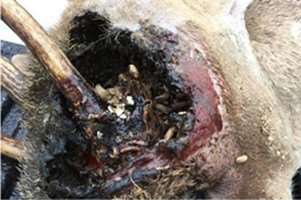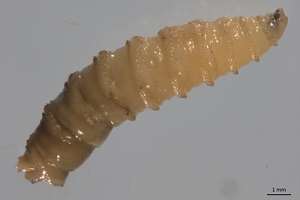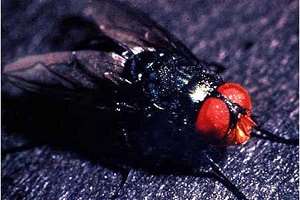Screwworms were eradicated from the Southeast back in 1959. This week USDA’s Animal Plant Health Inspection Service (APHIS) confirmed the presence of New World Screwworms Cochliomyia hominivorax in three deer in the Florida Keys. At this point, APHIS believes the infestation is isolated to Big Pine Key and No Name Key, but the USDA is moving forward with additional surveillance, fly trapping in the region, as well as the release of sterile flies to stop the spread of this pest. The Florida Department of Agriculture (FDACS) has established an Animal Health Zone in the keys, with a checkpoint at mile marker 106 to check all animals coming out of the keys for screwworms.

“The screwworm is a potentially devastating animal disease that sends shivers down every rancher’s spine. This pest poses a grave threat to wildlife, livestock and domestic pets in Florida. We’ve eradicated this from Florida before, and we’ll do it again. We will work with our partners on the federal, state and local level to protect our residents, animals and wildlife by eliminating the screwworm from Florida. The public’s assistance is crucial to the success of this eradication program.” Florida Commissioner of Agriculture Adam Putnam

Screwworms
New World Screwworms also called Primary Screwworms are actually fly larvae (maggots) that feed on open wounds of livestock, wildlife, pets, and even on rare occasion people. The adult screwworm fly is slightly larger than a common house fly, but has large orange eyes and a dark blue metallic body. The adult flies lay their eggs on open sores, wounds, navels of newborn animals, or mucous membranes. The maggots hatch-out within a day and feed on the living flesh of the host animal for five to seven days before leaving the animal and tunneling in the ground. The screwworms grow to a length of up to 2/3 of an inch before leaving the host animal wound and pupating in leaf litter or the soil surface . The adult flies emerge from the ground in 7-10 days, mate only once, and complete the 24 day life-cycle. Unlike other flesh-eating blow-flies, screwworm flies only lay their eggs on living flesh wounds. Left untreated, infected animals may perish from toxicity build up or secondary infections after 7-14 days. This was a devastating insect pest for the Florida Cattle industry in the 1950’s, before USDA developed the eradication method of releasing sterile male flies. Because the female flies mate only once, the release of sterile male flies is a very effective tool to significantly reduce populations.
With screwworm flies present, any open wound from castration, dehorning, branding, shearing or clipping, barbed wire fences, or other causes can attract the adult flies to lay their eggs. The most obvious sign of infestation is a significant change in the appearance of a wound. The wound will become more enlarged and much deeper with noticeable drainage, which can attract additional flies. It is difficult to actually see the screwworms in the early stages of feeding, but as many as 200 maggots may be found in a single wound. Infested wounds smell rotten and will often have bloody discharge. Wounds that are not healing properly, or are producing excessive drainage should be inspected for screwworms.

Be on the Lookout
It is important that every livestock producer, pet owner, hunter, and wildlife enthusiast in Florida be on the lookout for this pest. Though adult flies generally do not fly more than a few miles in search of host animals, they can fly much farther if necessary. Hurricanes have been known to bring other invasive pests to Florida. There is potential for this pest to be spread as Hurricane Matthew blows through week, or by other storms in the future. The more likely spread of this pest will come with animal movement. This is why FDCAS has set up the roadblock to check pets and animals coming into mainland Florida from the keys. This is just one more reason why it is important for livestock producers to quarantine new animals that are purchased or moved to an operation for observation, before adding them in with primary herd.
While this is currently a very isolated issue, way down in the Florida Keys, it is important that animal owners in Florida are aware of the signs and symptoms from this potentially devastating pest. Livestock producers, and pet owners should report any potential cases to 1-800-HELP-FLA (1-800-435-7352) and consult with your veterinarian for wound treatment. Non-Florida residents should call (850) 410-3800.
Source: ufl.edu